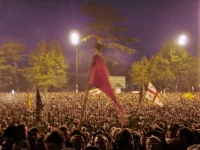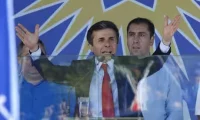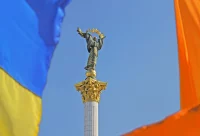As the United States watches its 2020 election season drag on longer than most presidential elections, the highly charged partisan domestic environment raises concerns over possible protest against the final results. It is an illustration that paints the twenty-first century very well; this century has become an early indicator of electoral revolutions. From across the Atlantic to the Old World, history provides several examples of protest against controversial elections of leaders fighting to maintain the status quo. These elections were remembered for electoral malfeasance, popular reactions often marked by public protests, and by the government’s response.

In Eastern Europe, two “color” revolutions in the new century come to mind. In 2003 Georgia, which had been suffering from economic mismanagement and government corruption, the Rose Revolution began with widespread protests over the disputed parliamentary elections. The International Election Observation Mission led by the Organization for Security and Cooperation in Europe (OSCE) discovered electoral fraud—such as stark differences between official and unofficial vote counts—and concluded that the elections fell short of OSCE and international standards. When President Eduard Shevardnadze refused to void the results and, later, refused to resign from office, it sparked a twenty-day revolution from anti-government protestors led by opposition parties like Mikheil Saakashvili’s National Movement. Opposition parties took the revolution’s leadership role, increasing the support against the Shevardnadze government.
President Shevardnadze’s position proved fragile. As a special negotiator for Eurasian conflicts, Ambassador Rudolf V. Perina, in an interview with ADST, described President Shevardnadze as being widely unpopular with an unhappy Georgian population. His popularity rating was significantly low, and he had lost the confidence of the people. The country was facing a revolution standoff between non-violent anti-government protesters and the military. The central streets of Tbilisi witnessed campaigns of civil disobedience, and Kmara, a youth organization, became a key factor for non-violent protests and government reform. The government sent soldiers to suppress the unrest, but as the revolution carried on, more and more people—including eventually the soldiers—joined the movement. By nightfall on November 23, the government lost its right for authority, and more than 100,000 protestors celebrated as Shevardnadze penned his letter of resignation. This paved the way for a new government under Saakashvili.
Inspired by the Georgian Rose Revolution, the Orange Revolution in Ukraine followed the disputed November 2004 Ukrainian presidential election between sitting Prime Minister Viktor Yanukovych and the opposition candidate Viktor Yushchenko, leader of the Our Ukraine faction in the Ukranian parliament. Yanukovych saw Yushchenko—who led after the first round of voting—as a threat. Consequently, Yanukovitch tried to rig the election in his favor, but it was marred by massive corruption, voter intimidation, and election fraud. The people, who had already lived under corrupt administrations, were not fooled by these tactics, which further fueled internal distaste for the government.

Carol A. Peasley was in Ukraine as an official international observer of the 2004 presidential election. While she was there, she saw the passion of the protesters. In an interview with ADST, she said the people in Kiev were “waving their orange flags and chanting for democratic change.” There were demands for annulling the presidential election and calls for a free and fair election. One million people took part in the revolution. In Kiev, the Yushchenko supporters outnumbered the pro-Yanukovych demonstrators significantly. Ultimately, their voices were heard, and the original results were annulled, thus allowing for a re-run election. Although Yanukovych attempted to challenge any result that went against him, the Ukrainian Supreme Court dismissed all the attempts. The Orange Revolution concluded peacefully as Viktor Yushchenko was sworn in as president.
In this “moment” in U.S. diplomatic history, we see that corruption and threats to free elections have sparked such electoral revolutions in the early twenty-first century. Foreign affairs professionals Ambassador Rudolf V. Perina and Carol A. Peasley share their perspective regarding these revolutions: their causes, their public reactions, and their resolutions. Historically, the Rose and Orange revolutions were only the beginning. Elections became controversial in many other countries: the Tulip Revolution (2005) in Kyrgyzstan, the Jeans Revolution (2005) in Belarus, protests against President Enrique Peña Nieto (2012) in Mexico, as well as the Arab Spring (2010-2012) in various countries in the Arab world. Several oral histories in the ADST collection have more first person accounts of these electoral revolutions.
Drafted by Derek Gutierrez
ADST relies on the generous support of our members and readers like you. Please support our efforts to continue capturing, preserving, and sharing the experiences of America’s diplomats.
Read Ambassador Rudolf V. Perina’s full oral history HERE and other information about the Rose Revolution HERE.
Read Carol A. Peasley’s full oral history HERE and other information about the Orange Revolution HERE.
Read more about other electoral revolutions: the Tulip Revolution HERE; and the Arab Spring HERE.
Excerpts:
Ambassador Rudolf V. Perina
Washington, D.C.—Special Negotiator, Eurasian Conflicts 2001–2004
“By coincidence this also happened to be the weekend that Shevardnadze was toppled from power in Georgia by demonstrations…”
Russian environment during the Rose Revolution:

PERINA: The Russians wanted the document signed by Voronin and Smirnov prior to the Maastricht Ministerial meeting, and they thus knew they had to make it public. They put it on an internet website, where it began circulating. The reaction was outrage, not just among Western governments but also among Moldovans. By late November, there were demonstrations in Chisinau of up to 50,000 people by some estimates protesting the memorandum. It seemed neither Voronin nor Kozak had anticipated such a reaction, but Putin was going forward with plans to fly to Chisinau for the signing ceremony early in the week of November 23. I was in Vienna at this time involved in the final OSCE preparations for Maastricht. I remember walking along the street in the early afternoon of November 21 and getting a call on my cell phone. It was Voronin’s office saying that he wanted to speak with me.
He got on the line and asked me what I thought the U.S. reaction would be if he signed the memorandum. I told him that it would be very negative, and that he would lose the support of the United States and most other Western countries as well. He told me he was reconsidering the entire memorandum and would make a decision that weekend. Well, as we later found out, on the eve of Putin’s departure for Chisinau, Voronin told the Russians he would not sign and cancelled the signing ceremony. We heard from many sources after that that Putin was just furious at Voronin. What Putin hoped would be a triumph of Russian peacemaking turned out to be a huge personal embarrassment. It led to a major deterioration in Russian-Moldovan relations.
Still, the Russians have never given up on the Kozak approach to resolving this conflict, and they continue to put pressure on Voronin to accept such an approach. He has so far resisted, to his credit, but he is unpredictable in these things and could still change his mind. I like to think that I played a role in preventing him from signing the 2003 document, though the situation was such that there were other Western governments démarching him at the time, and our bilateral Ambassador Heather Hodges also delivered a formal demarche from Washington against signing the memorandum. In retrospect, however, I think the factor that influenced Voronin most were the domestic demonstrations. By coincidence this also happened to be the weekend that Shevardnadze was toppled from power in Georgia by demonstrations—the weekend of the Rose Revolution. I think this is what scared Voronin most. He saw what happened to Shevardnadze. While Moldova’s demonstrations were still manageable, Voronin did not want to take the chance of the same thing happening to him and that is why he decided not to sign.
Q: Given all this, what was your assessment of the U.S. role in all of these frozen conflicts? Was there really a role for the U.S.?
PERINA: I think there was a role in two respects. First, as I mentioned, it is important to keep a negotiating process, a diplomatic track, going in all of these conflicts. If there is no diplomatic activity, the only alternative for those wishing to change things is war. The participation of the U.S. is important to giving most of these negotiations credibility and support. Secondly, the U.S. role is also important as a counter-weight to the Russians. The Moldovans and others understood this, and that is why they always wanted the U.S. engaged in the negotiations. The European Union, for all its good efforts, is still not cohesive or organized or fast enough to be able to stand up to the Russians when it becomes necessary. At the same time, I think it is true that none of these conflicts can be resolved without Russian cooperation. Russia’s influence in this part of the world is just too great and likely to remain so. In the case of Transnistria, Abkhazia, and South Ossetia, Russia is in fact the key factor that perpetuates the conflicts. In the case of Karabakh, the Russians cannot force a settlement, but they can be spoilers and prevent one if they choose to do so.
**********************************************************
Carol A. Peasley
Washington, D.C.—Counselor, USAID Office of the Administor 2003–2005
“It certainly was interesting to see the people camped in the main plaza in Kyiv waving their orange flags and chanting for democratic change.”

Observation of the Orange Revolution:
Q: Did your job take you overseas at all?
PEASLEY: Yes; I did a couple of things. One was very ad hoc and not really associated with my position, but also very interesting. I volunteered to be an election monitor in Ukraine for the December 26, 2004 presidential run-off election. I knew that it would be difficult to recruit monitors over the Christmas holiday and I thought my even rudimentary Russian language skills could be helpful. As you may recall, this was the “Orange Revolution” in Ukraine. It certainly was interesting to see the people camped in the main plaza in Kyiv waving their orange flags and chanting for democratic change. I ended up observing in Kyiv where everything operated very smoothly. While the proponents of that “revolution” prevailed in the election, the past ten years certainly have been disappointing. But, it was nice to have witnessed the early positive days of the change.
More importantly, I headed up a mission management assessment of the USAID office in Bangladesh. One of the recommendations coming out of the Policy Bureau’s business model study was to conduct mission management assessments in each USAID office every five years. These kinds of management assessments had been done in the 1980s and early 1990s, but had dropped away. Many of us felt that they had been very useful, so we recommended that they be reinstituted. A four-to-five person team would do the assessments, and they would look comprehensively at the program and management. There would be formal reviews in Washington, and lessons learned would be shared across the agency when applicable. One of the responsibilities of the Counselor was to coordinate these assessments and to manage the process, including identification of teams and missions to be assessed. We wanted to time the assessments so they could be most useful to a mission, for example early in a new mission director’s tenure or when some other kind of significant change might be happening.
